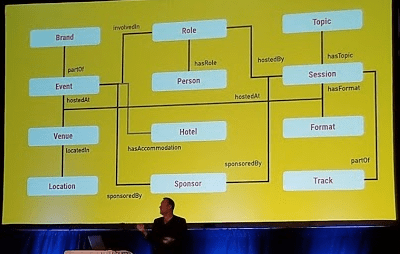The second day of the Digital Summit Seattle built on the momentum of day one, which I covered in a previous post. As a veteran digital marketer since 1996, it can be tough to maintain interest or gain new insights, but Digital Summit delivered on multiple fronts. Below is a high-level summary of insights from the sessions I attended. For a more in-depth exploration, I recommend following the #digitalsummit and #dssea hashtags on Twitter.
Designing Connected Content, Mike Atherton, Facebook
Mike reminds us that most consumers are consuming content via social media, vs. through your corporate website. As a marketer, you need to be where your audience is and providing them information in a way that they prefer: format, frequency, design, etc. Oftentimes, the structure of content is an illusion. Mike gives a site architecture as an example, where the structure is somewhat arbitrary, vs. embedded in the content themselves. An example of the new mode of navigation is Google’s sidebar or search results pages, where content is linked based on relevance vs. hierarchy.
The concept of Connected Content is…
• Specifically about the things that matter to an audience
• Structured according to how these things connect in the world
• Stored outside of any interface, ready for use in every interface
One tip Mike outlined, is to Map The World. Determine how content links together as you create it. Embed links to connect content and context. These relationships create value and help paint a clear picture. The technical term is Domain Modeling. Here’s an example:

Once you’ve mapped out your link structure, the next step is to open the windows. Rather than take a traditional UX/UI design approach, Mike recommends separating concerns into three categories: interface, content and domain model. Overall, the session was insightful in rethinking the content and design creation and integration process.
Ignore at Your Peril: 9 Trends That Will Shape Marketing in 2019, Loren McDonald, IBM Watson Marketing
This session covered trends shaping marketing. A few of those trends, as outlined by Loren, include:
1. Integrating Marketing & Customer experiencer: always be thinking about the Customer Journey in everything you do.
2. Eliminate data silos: ensure data is being shared across platforms to inform the customer journey and targeting marketing effectively.
3. Monitor real-time customer struggles: identify and address customer friction points.
4. AI and Machine Learning: it’s the future, but it’s only as good as the data being fed to it
5. Digital marketing agencies transformed into consultancies: Accenture, Deloitte and other big consulting firms have incorporated digital marketing into the service offering, to be competitive, spur growth and enhance relationships with clients. Loren advises going niche or expand on the agency side. Brands, conversely, need to decide who they want to work with… who is going to best meet their needs and help achieve goals.
6. Regulations & GDPR: Loren believes its largely a good thing. While meeting with legal isn’t fun, it’s important, considering 55 percent of consumers prefer not to share personal data. As a result, there are a few key steps to take to be compliant: focus on data hygiene, instilling trust, acquisition quality and rethinking metrics.
7. Agile Marketing: 37 percent of marketers report they’ve adopted some flavor of agile marketing. Agile is a tactical marketing approach that allows teams to divide marketing workflow into smaller chunks and iterate over a shorter period of time.
8. MarTech + AdTech are coming together. 86 percent of digital display ads in the US will be programmatic by 2020. Media buyers are most at risk with the evolution of automated media buying, bidding and measuring. Related tech includes Demand Side Platform (DSP) and Data Management Platform (DMP), which both help brands and marketers understand the impact of advertising throughout the customer journey.
9. Customer Centricity will drive customer innovation. Everything is a subscription these days, from cars and razors to food and clothing. This model provides critical margins for businesses with largely compressed profits. Unfortunately, companies have to restructure to better serve customers… with a customer-centered approach vs. discipline silos.
10. Bonus: In the emotion economy, purpose creates loyalty. Loren uses Kaepernick and Nike as an example. Good idea, since I’ve shared my thoughts on the Nike Just Do It campaign when it launched last year. Brands are selecting their customers based on purpose, which implies fans are more engaged and others are fired. I agree this is a powerful trend, as does the Anvil team.
Build a Loyal Base of Listeners: B2B Podcasting, Sean Campbell, Cascade Insights
Of course I felt obligated to attend this session on podcasting, as that was my topic as a Digital Summit presenter and I’ve written about developing a podcasting strategy. According to Sean, he believes too many marketers or brands are just shouting and need to stop. Cascade built a podcast a few years ago (now at 200 episodes) and Sean shared his experiences and lessons with the audience.
His overall philosophy is that consumers want content to be “narrow” so the goal is to deliver, while appealing to the broadest audience. Sean reminded the audience that audio quality is the “location, location, location” of podcasting. Don’t cut corners on your audio quality. Also, don’t cut corners without editing, which is essential to streamline the flow and make it more engaging. Sean recommends against self-hosting podcasts; use Libsyn or other podcasting host platforms. He also recommends finding a niche (topic/theme) and sticking to it. Your podcast shouldn’t be for everyone, it should be for those that matter to you – your target audience.
Don’t forget to talk up your podcast with your customers/clients and other important constituents, especially considering they are the primary or secondary target audience. As a result, it’s okay to engage the sales team and incorporate sales messaging. In fact, Sean recommends crowdsourcing questions from your customers and prospects to help formulate the content, guests and format. Pro tip: pre-record questions from your audience and air during the show when high-profile guests are only available outside of your planned recording sessions.
Advertising isn’t a bad thing, especially when integrated properly. Overcast and Podcast Republic are effective ad platforms that generate new listeners/subscribers for very little ($400 or so per campaign, based on demand). Most ads run for 30 days, which is good for reach and recall. Sean also recommend a mid-roll ad (15 seconds) to promote your business in the middle of your podcast. Use Voices.com for quality voice talent for ads.
In terms of guests, shoot for the moon with thought-leaders, influencers and otherwise engaging guests (funny, informative or unique). Don’t get trapped in thinking a job title or level of experience makes a great interview. Vet and prep your guests in advance. Think quality over quantity, not just in terms of guests or content but podcast frequency. Most guests tend to create evergreen content, which is inherent to the interview format. While attribution can be challenging due to limited metrics, it can be powerful. For example, the podcast we helped produce and market, Craving the Future, generated a global hotel consulting client for our customer.
Conversational Strategies to Reach Today’s Consumer, Grad Conn, Sprinklr
In this session, Grad outlines the concept of B2B social account-based marketing. Specifically, the concept is prospecting targeted (named) accounts in social via a programmatic approach. Grad outlines the concept of CXC, where mentions are distributed through the company via the Sprinklr application. If you don’t understand what a CXC is, worry not, as it’s Sprinklr-specific jargon as far as I can tell. To help illustrate the concept, he used Burger King as an example.
Grad goes on to outline the process for ABM:
1. Identify account based on success levels of traditional outreach methods, revenue or employee size targets, brands are engaged in social (specific to Sprinklr)
2. CXC team is activated and begins ABM research process (to learn more about the brand and key contact
3. CXC team develops a research brief to provide context for engagements
4. Set up listening to asset with research and develop key insights (using Sprinklr platform)
5. Look for opportunities to create and share custom content that engages the prospect
One example used was the CMO of Sonos, and how they targeted her after she moved to Lyft. They developed custom “congrats” creative and shared it directly with her via social (from Sprinklr profile). A second example was the CMO of Mastercard, who received custom creative, resulting in sharing and a thank you.
The conference will continue this afternoon, but I won’t be able to provide recaps. I recommend attending a future Digital Summit in your city or better yet, in Portland!

Kent Lewis founder of pdxMindShare, an online career community and networking group mentioned on Seth Godin’s blog. Formerly a CMO and founder or co-founder of multiple agencies, he’s known as a thought leader in digital marketing. He’s been an adjunct professor for more than 20 years at Portland State University and a volunteer instructor for SCORE. Lewis co-founded SEMpdx in 2006, a trade organization for search engine marketing professionals. His recognition includes Marketer of the Year by the American Marketing Association and Top 100 Digital Marketing Influencers by BuzzSumo.
